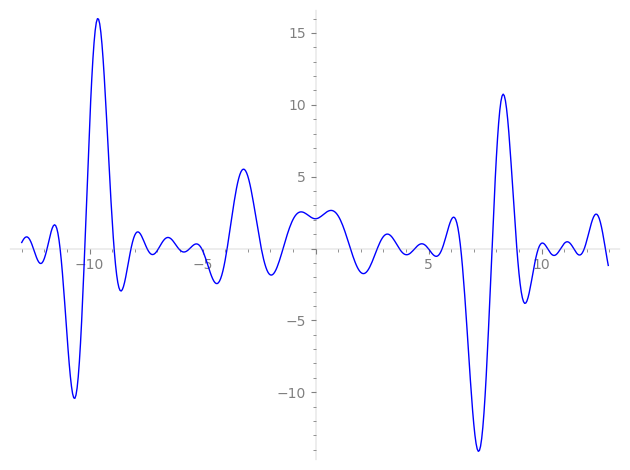| L(s) = 1 | + (1.14 + 1.14i)2-s + (−0.619 − 1.49i)3-s + 1.61i·4-s + (0.570 − 0.236i)5-s + (1.00 − 2.41i)6-s + (0.923 + 0.382i)7-s + (−0.707 + 0.707i)8-s + (−1.14 + 1.14i)9-s + (0.923 + 0.382i)10-s + (2.41 − 1.00i)12-s + (0.619 + 1.49i)14-s + (−0.707 − 0.707i)15-s − 2.61·18-s + (0.382 + 0.923i)20-s − 1.61i·21-s + ⋯ |
| L(s) = 1 | + (1.14 + 1.14i)2-s + (−0.619 − 1.49i)3-s + 1.61i·4-s + (0.570 − 0.236i)5-s + (1.00 − 2.41i)6-s + (0.923 + 0.382i)7-s + (−0.707 + 0.707i)8-s + (−1.14 + 1.14i)9-s + (0.923 + 0.382i)10-s + (2.41 − 1.00i)12-s + (0.619 + 1.49i)14-s + (−0.707 − 0.707i)15-s − 2.61·18-s + (0.382 + 0.923i)20-s − 1.61i·21-s + ⋯ |
\[\begin{aligned}\Lambda(s)=\mathstrut & 2023 ^{s/2} \, \Gamma_{\C}(s) \, L(s)\cr =\mathstrut & (0.950 - 0.311i)\, \overline{\Lambda}(1-s) \end{aligned}\]
\[\begin{aligned}\Lambda(s)=\mathstrut & 2023 ^{s/2} \, \Gamma_{\C}(s) \, L(s)\cr =\mathstrut & (0.950 - 0.311i)\, \overline{\Lambda}(1-s) \end{aligned}\]
Particular Values
| \(L(\frac{1}{2})\) |
\(\approx\) |
\(2.071731250\) |
| \(L(\frac12)\) |
\(\approx\) |
\(2.071731250\) |
| \(L(1)\) |
|
not available |
| \(L(1)\) |
|
not available |
\(L(s) = \displaystyle \prod_{p} F_p(p^{-s})^{-1} \)
| $p$ | $F_p(T)$ |
|---|
| bad | 7 | \( 1 + (-0.923 - 0.382i)T \) |
| 17 | \( 1 \) |
| good | 2 | \( 1 + (-1.14 - 1.14i)T + iT^{2} \) |
| 3 | \( 1 + (0.619 + 1.49i)T + (-0.707 + 0.707i)T^{2} \) |
| 5 | \( 1 + (-0.570 + 0.236i)T + (0.707 - 0.707i)T^{2} \) |
| 11 | \( 1 + (0.707 + 0.707i)T^{2} \) |
| 13 | \( 1 + T^{2} \) |
| 19 | \( 1 - iT^{2} \) |
| 23 | \( 1 + (0.707 + 0.707i)T^{2} \) |
| 29 | \( 1 + (-0.707 + 0.707i)T^{2} \) |
| 31 | \( 1 + (0.236 + 0.570i)T + (-0.707 + 0.707i)T^{2} \) |
| 37 | \( 1 + (0.707 - 0.707i)T^{2} \) |
| 41 | \( 1 + (1.49 + 0.619i)T + (0.707 + 0.707i)T^{2} \) |
| 43 | \( 1 + (-1.14 + 1.14i)T - iT^{2} \) |
| 47 | \( 1 + T^{2} \) |
| 53 | \( 1 + (0.437 + 0.437i)T + iT^{2} \) |
| 59 | \( 1 + iT^{2} \) |
| 61 | \( 1 + (-1.49 - 0.619i)T + (0.707 + 0.707i)T^{2} \) |
| 67 | \( 1 + 0.618T + T^{2} \) |
| 71 | \( 1 + (0.707 - 0.707i)T^{2} \) |
| 73 | \( 1 + (1.49 - 0.619i)T + (0.707 - 0.707i)T^{2} \) |
| 79 | \( 1 + (0.707 + 0.707i)T^{2} \) |
| 83 | \( 1 - iT^{2} \) |
| 89 | \( 1 + T^{2} \) |
| 97 | \( 1 + (0.570 - 0.236i)T + (0.707 - 0.707i)T^{2} \) |
| show more | |
| show less | |
\(L(s) = \displaystyle\prod_p \ \prod_{j=1}^{2} (1 - \alpha_{j,p}\, p^{-s})^{-1}\)
Imaginary part of the first few zeros on the critical line
−8.913192479064282015573797994002, −8.164125682051386720794932698082, −7.45548958323471617621637266338, −6.94609776800499056245272419593, −6.06330592733006214036956397121, −5.56499416047299701363034549685, −5.04343934729599666711732835008, −3.91280853343450327866441820185, −2.40127464653199000919777804610, −1.43735911759551115120097344838,
1.54131376722925450266988326317, 2.73256871117177292011514598061, 3.70231861418432194114665326447, 4.39435050125401813180732339237, 4.98582411332358257082009486585, 5.60330944336906368109941406688, 6.42286598128106570350222928008, 7.80680493695491968174432287533, 8.904805758545097501502156476238, 9.858153975496469796493141154342

